Purchas D. Handbook of Filter Media
Подождите немного. Документ загружается.

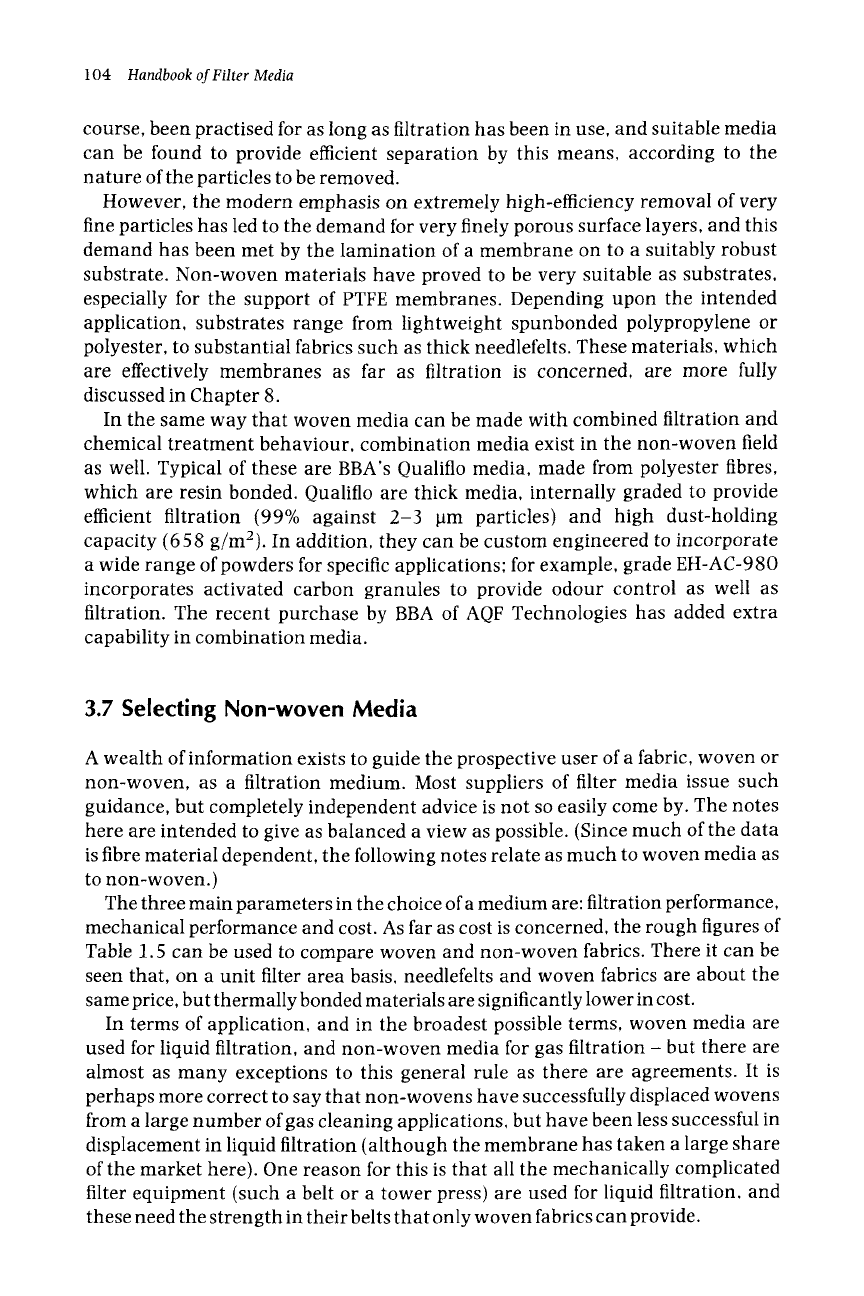
104
Handbook of Filter Media
course, been practised for as long as filtration has been in use, and suitable media
can be found to provide efficient separation by this means, according to the
nature of the particles to be removed.
However, the modern emphasis on extremely high-efficiency removal of very
fine particles has led to the demand for very finely porous surface layers, and this
demand has been met by the lamination of a membrane on to a suitably robust
substrate. Non-woven materials have proved to be very suitable as substrates,
especially for the support of PTFE membranes. Depending upon the intended
application, substrates range from lightweight spunbonded polypropylene or
polyester, to substantial fabrics such as thick needlefelts. These materials, which
are effectively membranes as far as filtration is concerned, are more fully
discussed in Chapter 8.
In the same way that woven media can be made with combined filtration and
chemical treatment behaviour, combination media exist in the non-woven field
as well. Typical of these are BBA's Qualiflo media, made from polyester fibres,
which are resin bonded. Qualiflo are thick media, internally graded to provide
efficient filtration (99% against 2-3 gm particles) and high dust-holding
capacity (658 g/m2). In addition, they can be custom engineered to incorporate
a wide range of powders for specific applications: for example, grade EH-AC-980
incorporates activated carbon granules to provide odour control as well as
filtration. The recent purchase by BBA of AQF Technologies has added extra
capability in combination media.
3.7 Selecting Non-woven Media
A wealth of information exists to guide the prospective user of a fabric, woven or
non-woven, as a filtration medium. Most suppliers of filter media issue such
guidance, but completely independent advice is not so easily come by. The notes
here are intended to give as balanced a view as possible. (Since much of the data
is fibre material dependent, the following notes relate as much to woven media as
to non-woven.)
The three main parameters in the choice of a medium are: filtration performance,
mechanical performance and cost. As far as cost is concerned, the rough figures of
Table 1.5 can be used
to
compare woven and non-woven fabrics. There it can be
seen that, on a unit filter area basis, needlefelts and woven fabrics are about the
same price, but thermally bonded materials are significantly lower in cost.
In terms of application, and in the broadest possible terms, woven media are
used for liquid filtration, and non-woven media for gas filtration - but there are
almost as many exceptions to this general rule as there are agreements. It is
perhaps more correct to say that non-wovens have successfully displaced wovens
from a large number of gas cleaning applications, but have been less successful in
displacement in liquid filtration (although the membrane has taken a large share
of the market here). One reason for this is that all the mechanically complicated
filter equipment (such a belt or a tower press) are used for liquid filtration, and
these need the strength in their belts that only woven fabrics can provide.
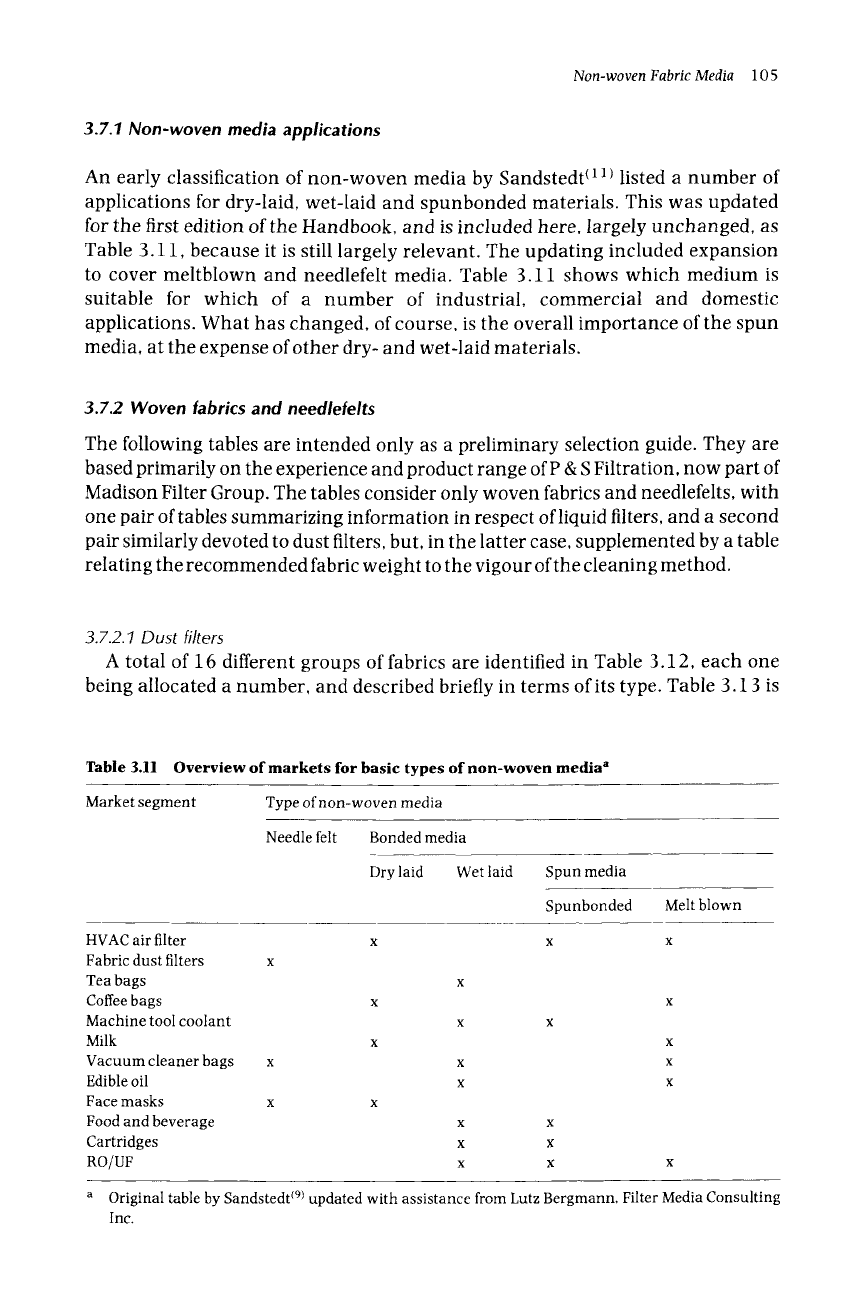
Non-woven Fabric Media 105
3.7.1 Non-woven media applications
An early classification of non-woven media by Sandstedt (1 a) listed a number of
applications for dry-laid, wet-laid and spunbonded materials. This was updated
for the first edition of the Handbook, and is included here, largely unchanged, as
Table 3.11, because it is still largely relevant. The updating included expansion
to cover meltblown and needlefelt media. Table 3.11 shows which medium is
suitable for which of a number of industrial, commercial and domestic
applications. What has changed, of course, is the overall importance of the spun
media, at the expense of other dry- and wet-laid materials.
3.7.2 Woven fabrics and needlefelts
The following tables are intended only as a preliminary selection guide. They are
based primarily on the experience and product range ofP & S Filtration, now part of
Madison Filter Group. The tables consider only woven fabrics and needlefelts, with
one pair of tables summarizing information in respect of liquid filters, and a second
pair similarly devoted to dust filters, but, in the latter case, supplemented by a table
relating the recommended fabric weight to the vigour of the cleaning method.
3.7.2.7 Dust filters
A total of 16 different groups of fabrics are identified in Table 3.12, each one
being allocated a number, and described briefly in terms of its type. Table 3.13 is
Table 3.11 Overview of markets for basic types of non-woven media a
Market segment
Type of non-woven media
Needle felt Bonded media
Dry laid Wet laid Spun media
Spunbonded Melt blown
HVAC air filter
Fabric dust filters x
Tea bags
Coffee bags
Machine tool coolant
Milk
Vacuum cleaner bags x
Edible oil
Face masks x
Food and beverage
Cartridges
RO/UF
X X
X X
X
X X
X X
X X
X X
X X
Sandsteut updated with assistance from Lutz Bergmann, Filter Media Consulting
a
Original table by J.9)
Inc.
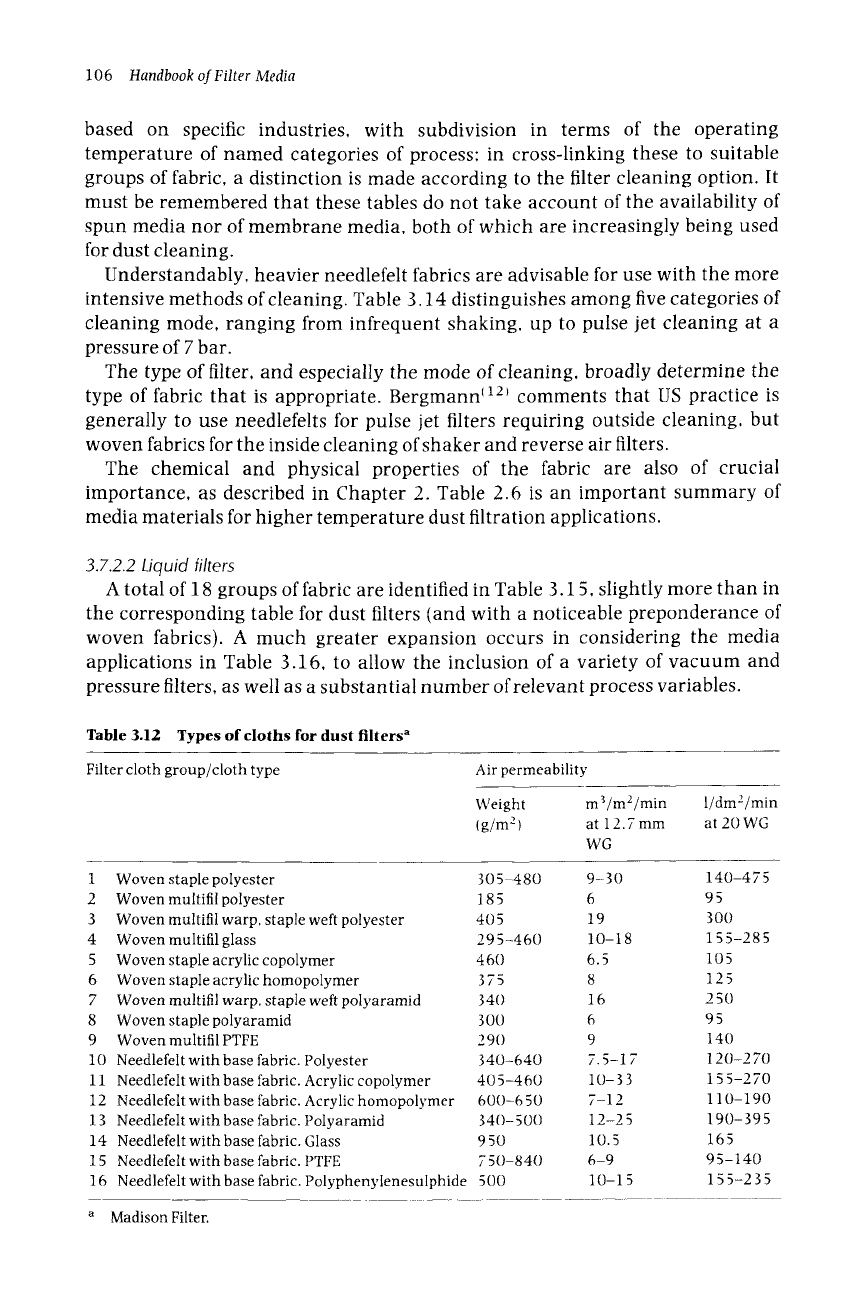
106
Handbook of Filter Media
based on specific industries, with subdivision in terms of the operating
temperature of named categories of process: in cross-linking these to suitable
groups of fabric, a distinction is made according to the filter cleaning option. It
must be remembered that these tables do not take account of the availability of
spun media nor of membrane media, both of which are increasingly being used
for dust cleaning.
Understandably, heavier needlefelt fabrics are advisable for use with the more
intensive methods of cleaning. Table 3.14 distinguishes among five categories of
cleaning mode, ranging from infrequent shaking, up to pulse jet cleaning at a
pressure of 7 bar.
The type of filter, and especially the mode of cleaning, broadly determine the
type of fabric that is appropriate. Bergmann ~12~ comments that US practice is
generally to use needlefelts for pulse jet filters requiring outside cleaning, but
woven fabrics for the inside cleaning of shaker and reverse air filters.
The chemical and physical properties of the fabric are also of crucial
importance, as described in Chapter 2. Table 2.6 is an important summary of
media materials for higher temperature dust filtration applications.
3.7.2.2 Liquid filters
A total of 18 groups of fabric are identified in Table 3.15, slightly more than in
the corresponding table for dust filters (and with a noticeable preponderance of
woven fabrics). A much greater expansion occurs in considering the media
applications in Table 3.16, to allow the inclusion of a variety of vacuum and
pressure filters, as well as a substantial number of relevant process variables.
Table 3.12 Types of cloths for dust filters a
Filter cloth group/cloth type Air permeability
Weight
m~/m2/min
1/dm2/min
(g/m 2) at 12.7 mm at 20 WG
WG
1 Woven staple polyester
2 Woven multifil polyester
3 Woven multifilwarp, staple weft polyester
4 Woven multifil glass
5 Woven staple acrylic copolymer
6 Woven staple acrylic homopolymer
7 Woven multifil warp. staple weft polyaramid
8 Woven staple polyaramid
9 Woven multifil PTFE
10 Needlefelt with base fabric. Polyester
11 Needlefelt with base fabric. Acrylic copolymer
12 Needlefelt with base fabric. Acrylic homopolymer
13 Needlefelt with base fabric. Polyaramid
14 Needlefelt with base fabric. Glass
15 Needlefelt with base fabric. PTFE
305-480 9-30 140-475
185 6 95
4O5 19 3OO
295-460 10-18 155-285
460 6.5 105
375 8 125
340 16 2 50
300 6 95
290 9 140
340-640 7.5-17 120-270
405-460 10-33 155-270
600-650 7-12 110-190
340-500 12-25 190-395
950 10.5 165
750-840 6-9 95-140
10-15 155-235
16 Needlefelt with base fabric. Polyphenylenesulphide 500
a Madison Filter.
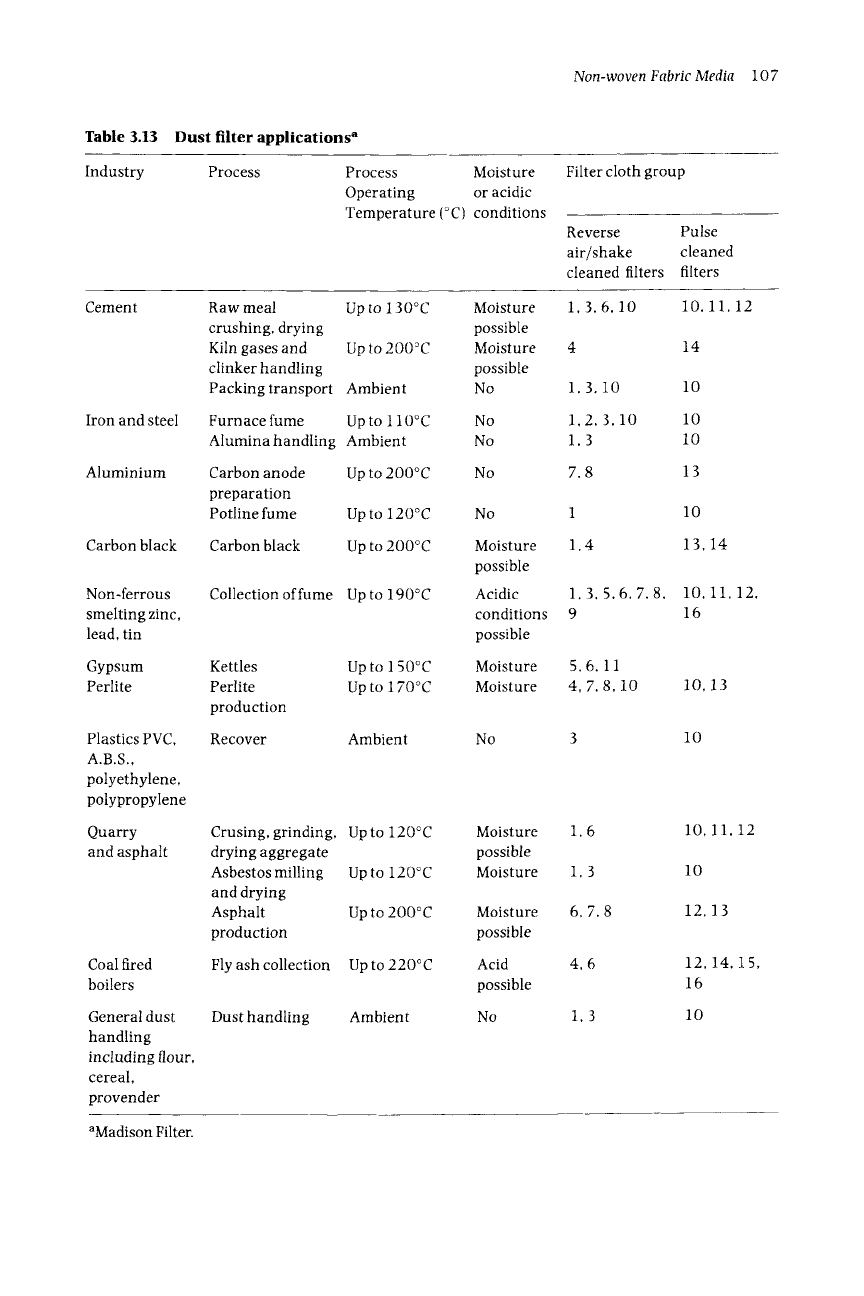
Non-woven Fabric Media 107
Table 3.13 Dust filter applications a
Industry Process
Process Moisture
Operating or acidic
Temperature (~ conditions
Filter cloth group
Reverse
air/shake
cleaned filters
Pulse
cleaned
filters
Cement
Iron and steel
Aluminium
Raw meal Up to 130~
crushing, drying
Kiln gases and Up to 200~
clinker handling
Packing transport Ambient
Furnace fume Up to 110~
Alumina handling Ambient
Carbon anode Up to 200~
preparation
Potline fume Up to 120~
Carbon black Carbon black Up to 200~
Non-ferrous
smelting zinc,
lead, tin
Gypsum
Perlite
Plastics PVC,
A.B.S.,
polyethylene,
polypropylene
Quarry
and asphalt
Coal fired
boilers
General dust
handling
including flour,
cereal,
provender
Collection of fume Up to 190~
Kettles Up to 150~
Perlite Up to 170~
production
Recover Ambient
Crusing, grinding, Up to 120~
drying aggregate
Asbestos milling Up to 120 ~ C
and drying
Asphalt Up to 200~
production
Fly ash collection Up to 220 ~
Dust handling Ambient
Moisture
possible
Moisture
possible
No
No
No
No
No
Moisture
possible
Acidic
conditions
possible
Moisture
Moisture
No
Moisture
possible
Moisture
Moisture
possible
Acid
possible
No
1.3.6.10
1.3.10
1.2, 3.10
1.3
7.8
1.4
1.3.5.6.7,8.
9
5,6.11
4,7.8,10
1,6
1,3
6.7.8
4.6
1.3
10,11,12
14
10
10
10
13
10
13,14
10, 11, 12,
16
10,13
10
10.11, 12
10
12,13
12,14,15,
16
10
aMadison Filter.
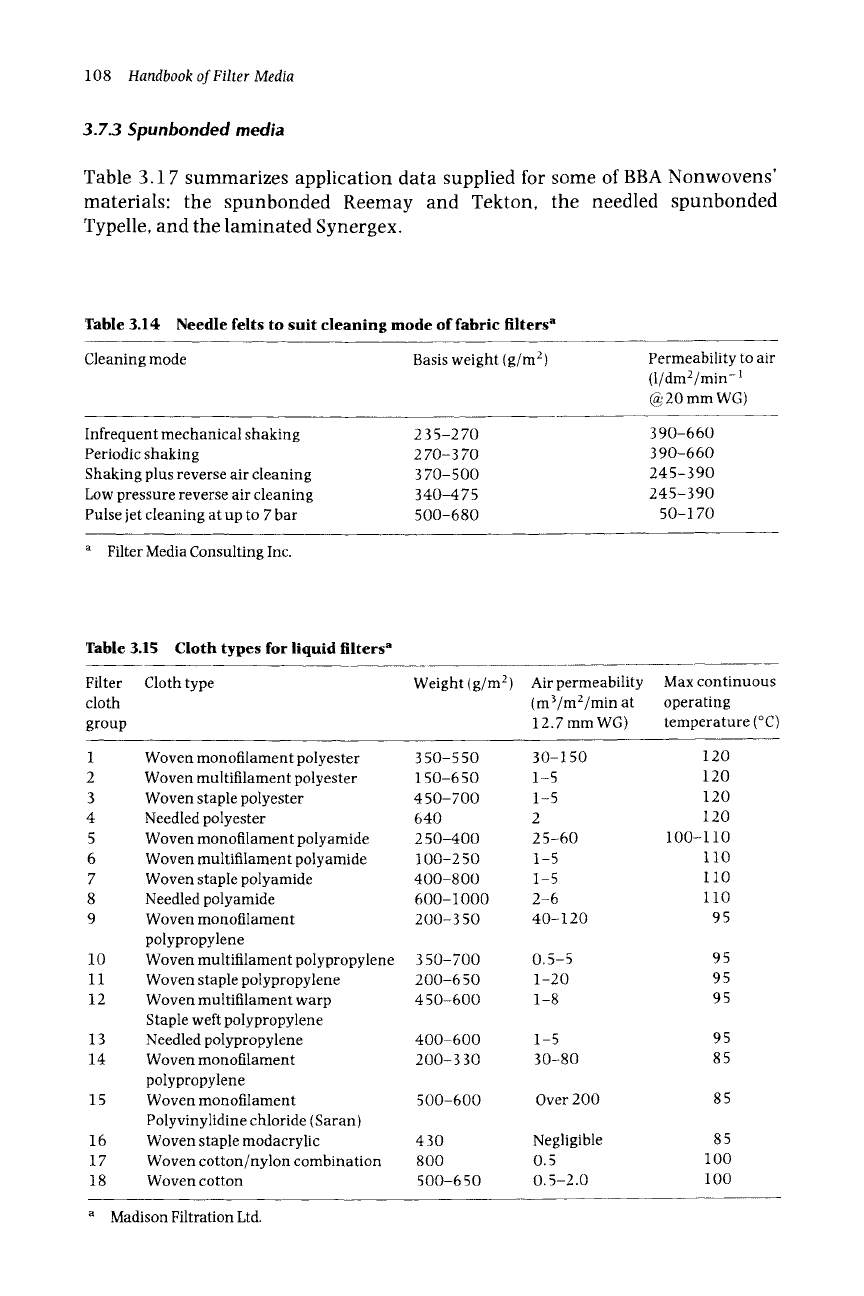
108
Handbook of Filter Media
3.7.3
Spunbonded media
Table 3.17 summarizes application data supplied for some of BBA Nonwovens'
materials: the spunbonded Reemay and Tekton, the needled spunbonded
Typelle, and the laminated Synergex.
Table 3.14 Needle felts to suit cleaning mode of fabric filters"
Cleaning mode Basis weight (g/m 2)
Permeability to air
(1/dm2/min -1
@20ram WG)
Infrequent mechanical shaking
Periodic shaking
Shaking plus reverse air cleaning
Low pressure reverse air cleaning
Pulse jet cleaning at up to 7 bar
235-270
270-370
370-500
340-4 75
500-680
390-660
390-660
245-390
245-390
50-170
a
Filter Media Consulting Inc.
Table 3.15 Cloth types for liquid filters"
Filter
cloth
group
Cloth type
Weight (g/m 2 ) Air permeability
(m3/m2/min
at
12.7 mm WG)
Max continuous
operating
temperature (~
1 Woven monofilament polyester
2 Woven multifilament polyester
3 Woven staple polyester
4 Needled polyester
5 Woven monofilament polyamide
6 Woven multifilament polyamide
7 Woven staple polyamide
8 Needled polyamide
9 Woven monofilament
polypropylene
10 Woven multifilament polypropylene
11 Woven staple polypropylene
12 Woven multifilament warp
Staple weft polypropylene
13 Needled polypropylene
14 Woven monofilament
polypropylene
15 Woven monofilament
Polyvinylidine chloride (Saran)
16 Woven staple modacrylic
17 Woven cotton/nylon combination
18 Woven cotton
350-550
150-650
450-700
640
250-400
100-250
400-800
600-1000
200-350
350-700
200-650
450-6OO
400-600
200-330
500-600
430
8O0
500-650
30-150
1-5
1-5
2
25-60
1-5
1-5
2-6
40-120
0.5-5
1-20
1-8
1-5
30-80
Over 200
Negligible
0.5
0.5-2.0
120
120
120
120
100-110
110
110
110
95
95
95
95
95
85
85
85
100
100
a
Madison Filtration Ltd.
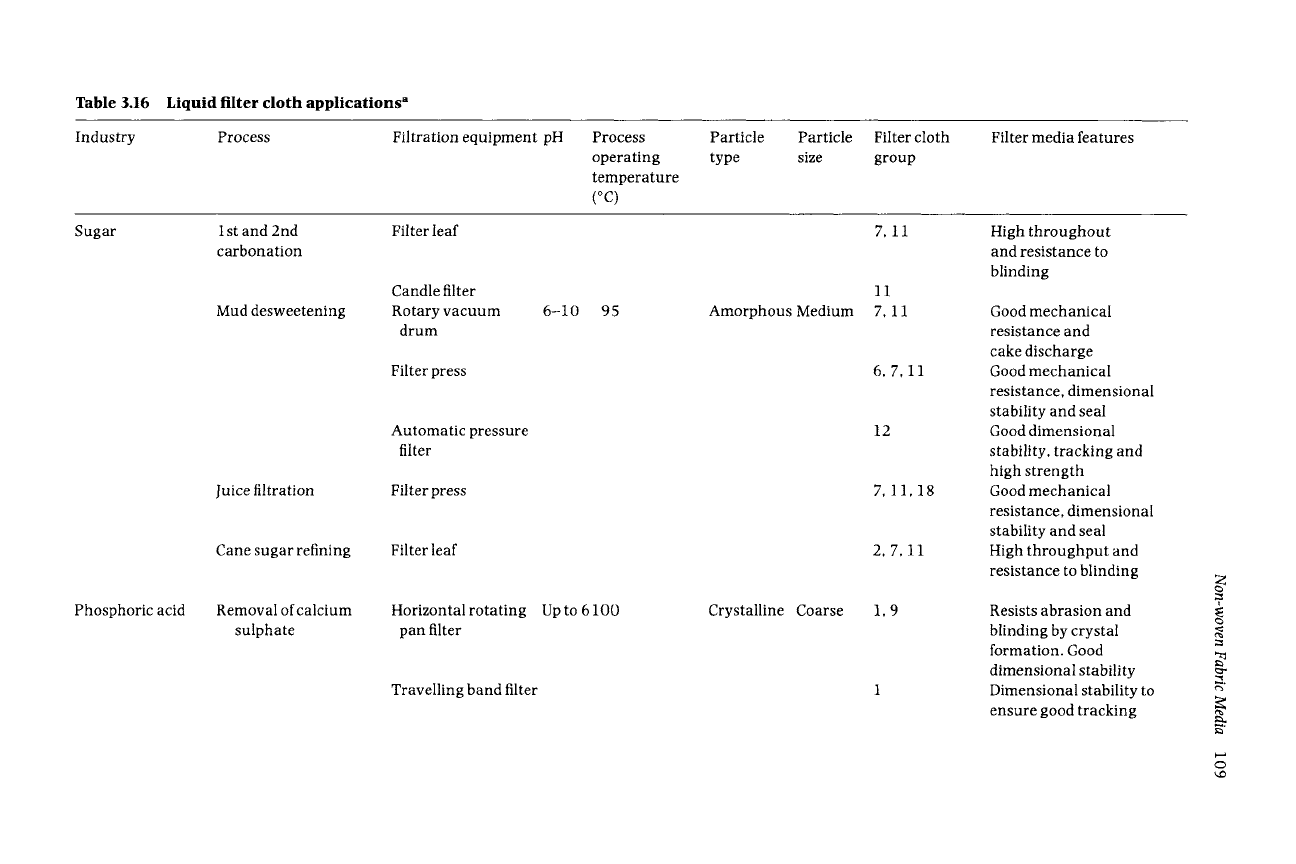
Table
3.16 Liquid filter
cloth applications a
Industry Process Filtration equipment pH
Process
operating
temperature
(oc)
Particle Particle Filter cloth
type size group
Filter media features
Sugar 1st and 2nd
carbonation
Mud desweetening
]uice filtration
Cane sugar refining
Phosphoric acid Removal of calcium
sulphate
Filter leaf
Candle filter
Rotary vacuum
drum
Filter press
Automatic pressure
filter
Filter press
Filter leaf
Horizontal rotating
pan filter
Travelling band filter
6-10 95
Upto6100
Amorphous Medium
7,11
11
7,11
6,7,11
12
7, 11,18
2,7,11
Crystalline Coarse 1, 9
1
High throughout
and resistance to
blinding
Good mechanical
resistance and
cake discharge
Good mechanical
resistance, dimensional
stability and seal
Good dimensional
stability, tracking and
high strength
Good mechanical
resistance, dimensional
stability and seal
High throughput and
resistance to blinding
Resists abrasion and
blinding by crystal
formation. Good
dimensional stability
Dimensional stability to
ensure good tracking
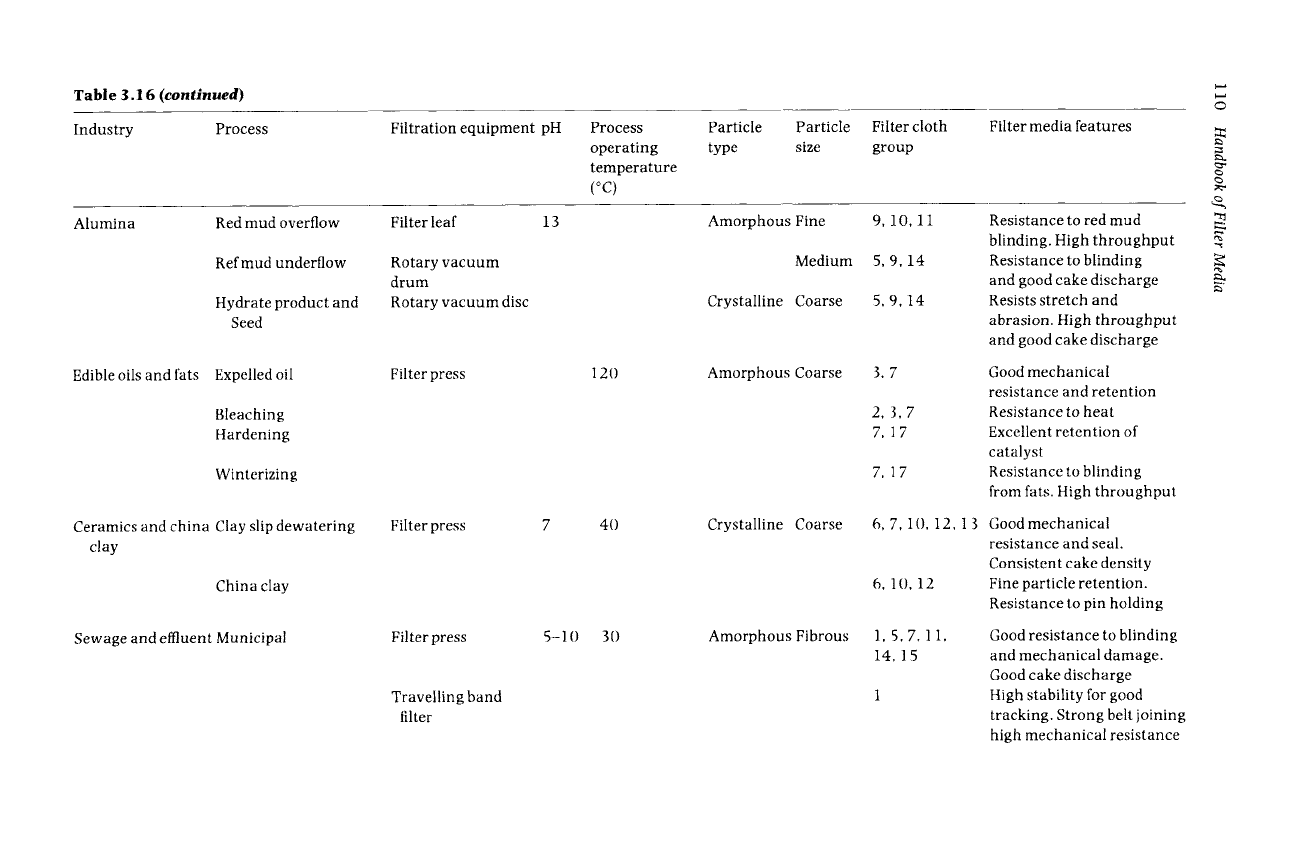
Table 3.16
(continued)
Industry Process
Filtration equipment pH
Process
operating
temperature
(oc)
Particle Particle Filter cloth
type size group
Filter media features
Alumina Red mud overflow
Refmud underflow
Hydrate product and
Seed
Edible oils and fats Expelled oil
Bleaching
Hardening
Winterizing
Ceramics and china Clay slip dewatering
clay
China clay
Sewage and effluent Municipal
Filter leaf 13
Rotary vacuum
drum
Rotary vacuum disc
Filter press
Filter press
Filter press
Travelling band
filter
5-10
120
4()
30
Amorphous Fine
Medium
Crystalline Coarse
Amorphous Coarse 3, 7
Crystalline Coarse
Amorphous Fibrous
9,10,11
5,9, 14
5.9, 14
2.3,7
7,17
7,17
6, 7, 1(), 12, 1 3
6. 10, 12
1,5,7,11,
14,15
Resistance to red mud
blinding. High throughput
Resistance to blinding
and good cake discharge
Resists stretch and
abrasion. High throughput
and good cake discharge
Good mechanical
resistance and retention
Resistance to heat
Excellent retention of
catalyst
Resistance to blinding
from fats. High throughput
Good mechanical
resistance and seal.
Consistent cake density
Fine particle retention.
Resistance to pin holding
Good resistance to blinding
and mechanical damage.
Good cake discharge
High stability for good
tracking. Strong belt joining
high mechanical resistance
e...
e~
e~
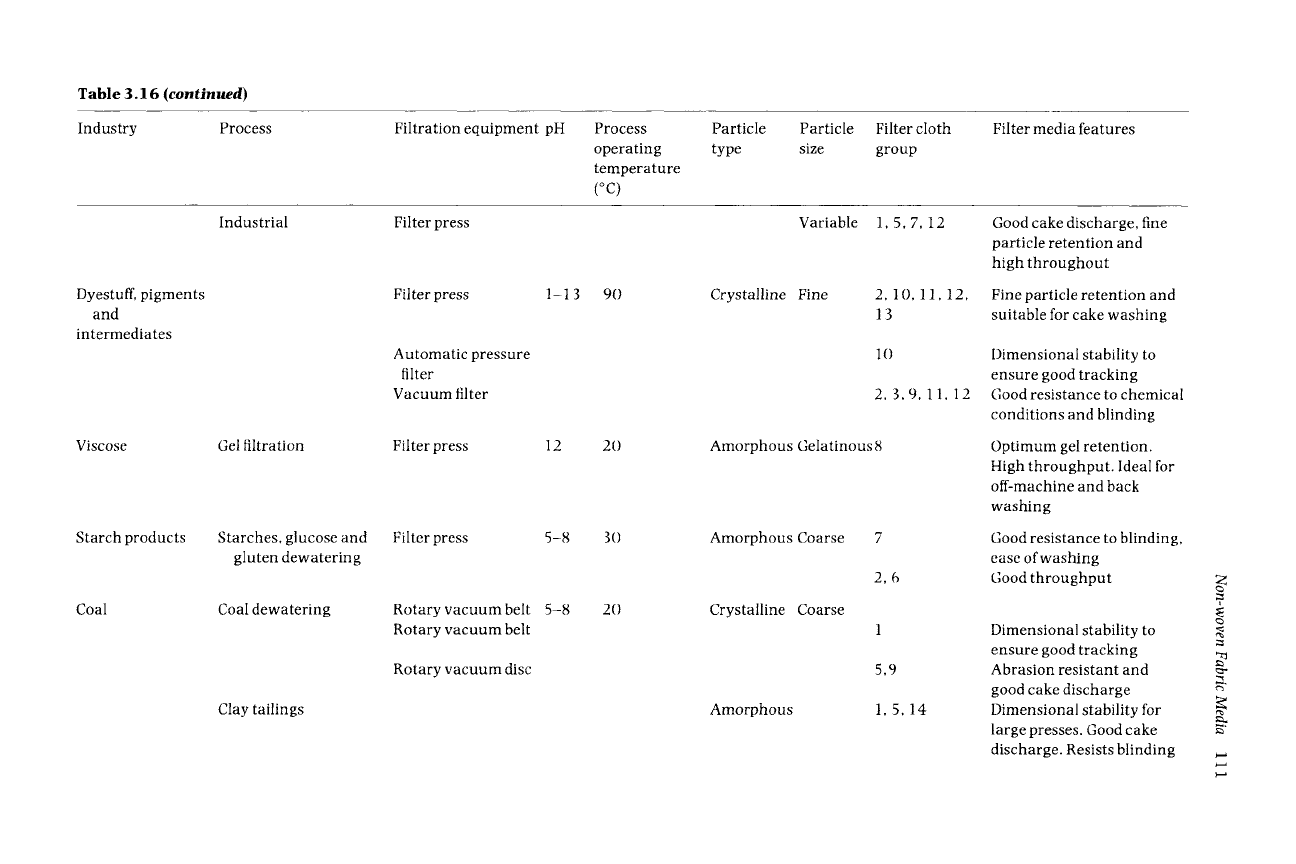
Table 3.16
(continued)
Industry Process Filtration equipment pH Process
operating
temperature
(oc)
Particle Particle
type size
Filter cloth
group
Filter media features
Dyestuff, pigments
and
intermediates
Viscose
Starch products
Coal
Industrial
Gel filtration
Starches, glucose and
gluten dewatering
Coal dewatering
Clay tailings
Filter press
Filter press 1-13
Automatic pressure
filter
Vacuum filter
90
Filter press 12 20
Filter press 5-8 30
Rotary vacuum belt 5-8
Rotary vacuum belt
Rotary vacuum disc
2O
Variable
Crystalline Fine
Amorphous Gelatinous8
Amorphous Coarse 7
Crystalline Coarse
Amorphous
1, 5,7, 12
2, 10, 11, 12,
13
10
2.3,9, 11, 12
2,6
1
5,9
1,5,14
Good cake discharge, fine
particle retention and
high throughout
Fine particle retention and
suitable for cake washing
Dimensional stability to
ensure good tracking
Good resistance to chemical
conditions and blinding
Optimum gel retention.
High throughput. Ideal for
off-machine and back
washing
Good resistance to blinding,
ease of washing
Good throughput
Dimensional stability to
ensure good tracking
Abrasion resistant and
good cake discharge
Dimensional stability for
large presses. Good cake
discharge. Resists blinding
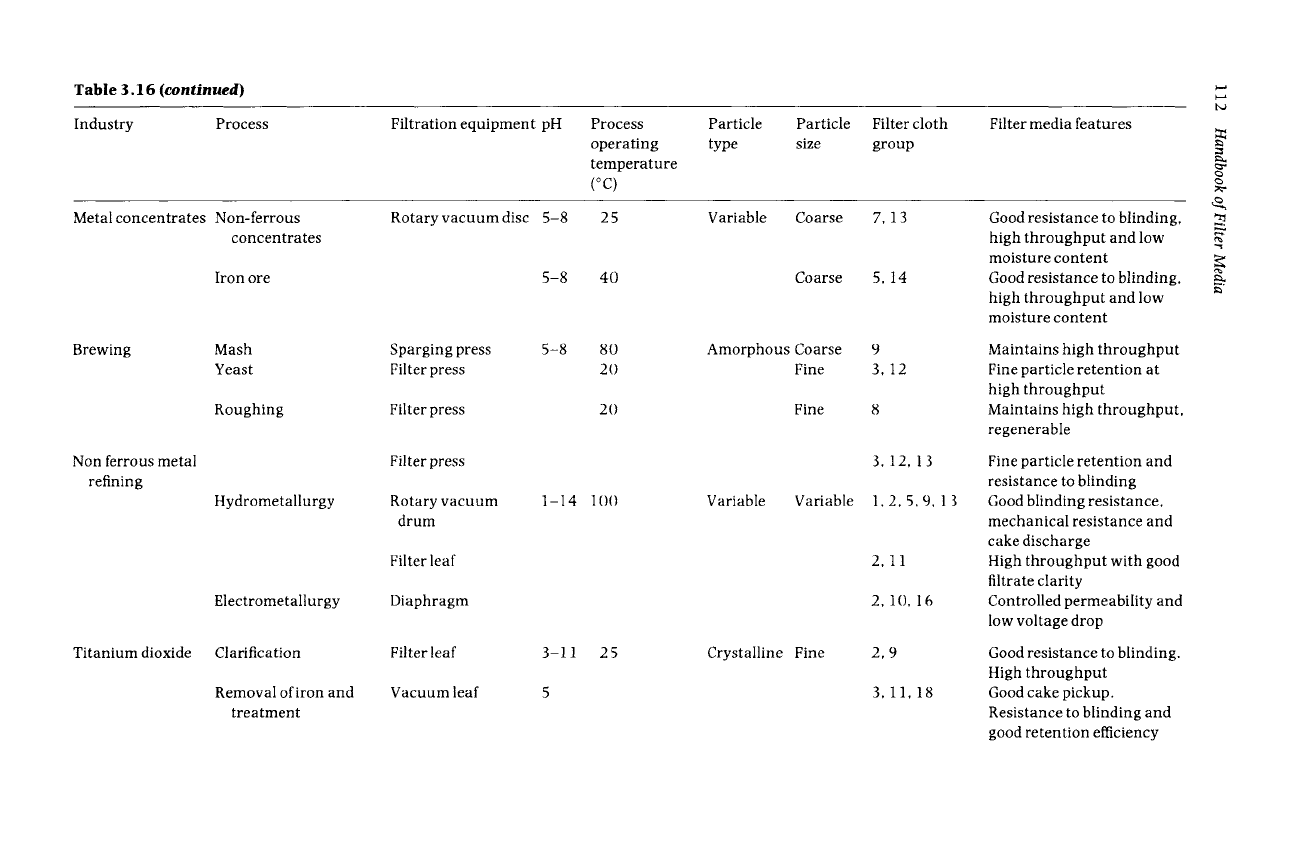
Table 3.16
(continued)
Industry Process
Filtration equipment pH Process
operating
temperature
(oc)
Particle Particle Filter cloth
type size group
Filter media features
a:
Metal concentrates Non-ferrous
concentrates
Iron ore
Brewing Mash
Yeast
Non ferrous metal
refining
Roughing
Hydrometallurgy
Titanium dioxide
Electrometallurgy
Clarification
Removal of iron and
treatment
Rotary vacuumdisc 5-8 25
5-8 40
Sparging press
Filter press
5-8
80
20
20
Filter press
Filter press
Rotary vacuum
drum
1-14 1 ()()
Filter leaf
Diaphragm
Filter leaf 3-11 25
Vacuum leaf
Variable Coarse 7, 13
Coarse 5, 14
Amorphous Coarse 9
Fine 3, 12
Fine 8
Variable Variable
3.12, 13
1,2,5.9, 13
2.11
2, 10, 16
Crystalline Fine 2, 9
3,11,18
Good resistance to blinding,
high throughput and low
moisture content
Good resistance to blinding,
high throughput and low
moisture content
Maintains high throughput
Fine particle retention at
high throughput
Maintains high throughput,
regenerable
Fine particle retention and
resistance to blinding
Good blinding resistance.
mechanical resistance and
cake discharge
High throughput with good
filtrate clarity
Controlled permeability and
low voltage drop
Good resistance to blinding.
High throughput
Good cake pickup.
Resistance to blinding and
good retention efficiency
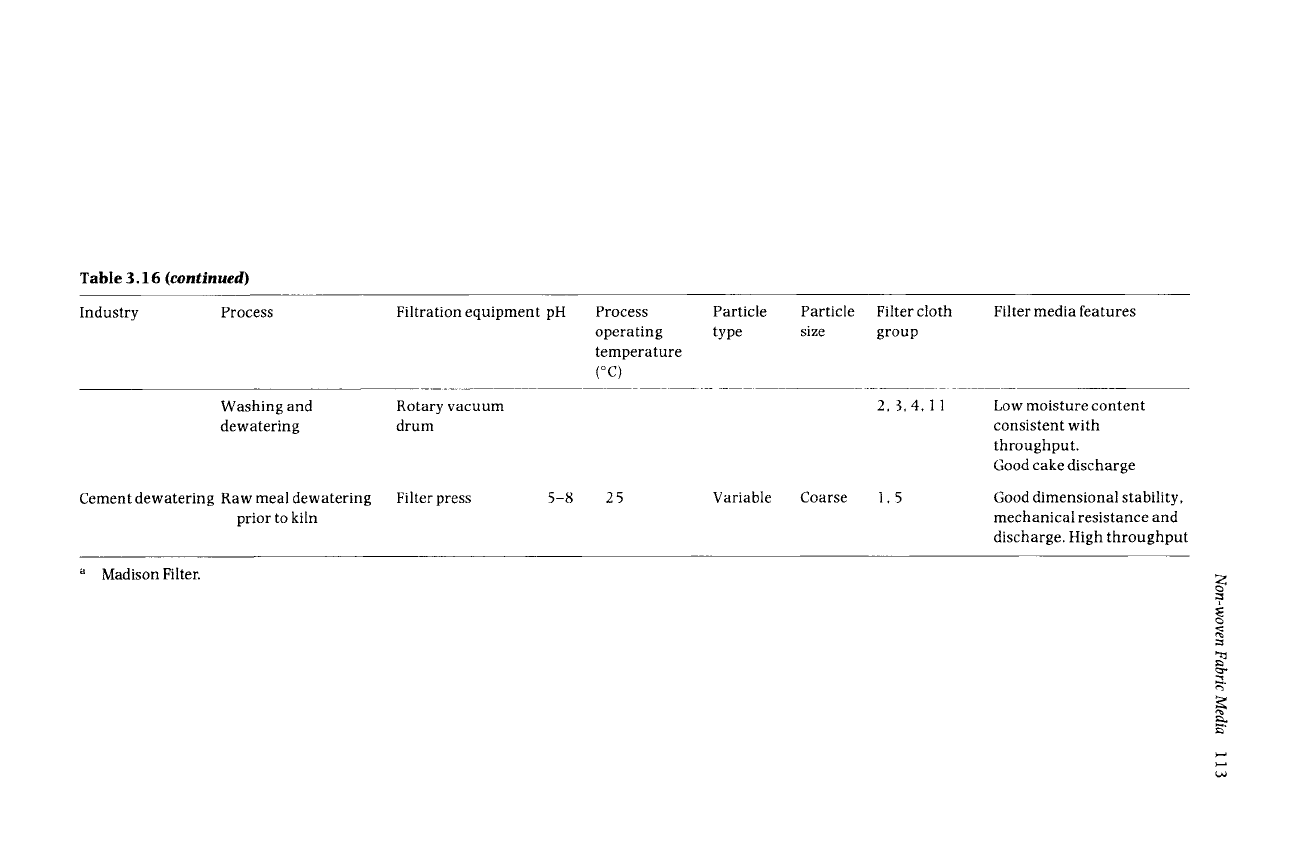
Table ].16
(continued)
Industry Process
Filtration equipment pH Process
operating
temperature
(~
Particle
type
Particle
size
Filter cloth
group
Filter media features
Washing and
dewatering
Cement dewatering Raw meal dewatering
prior to kiln
Rotary vacuum
drum
Filter press 5-8 2 5
Variable
Coarse
2,3,4,11
1,5
Low moisture content
consistent with
throughput.
Good cake discharge
Good dimensional stability.
mechanical resistance and
discharge. High throughput
a Madison Filter.
